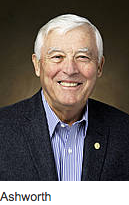 Delegates attending the congress of the International Union for Quaternary Research have elected Allan Ashworth, North Dakota State University Distinguished Professor-Emeritus of geology, president of their organization for 2015 to 2019.
Delegates attending the congress of the International Union for Quaternary Research have elected Allan Ashworth, North Dakota State University Distinguished Professor-Emeritus of geology, president of their organization for 2015 to 2019.
This year’s congress in Nagoya, Japan, provided a forum for more than 1,800 scientists from more than 50 countries to discuss the results of their research. Scientists in the organization include archaeologists, biologists, climatologists, geologists, oceanographers and soil scientists who work on every continent.
Quaternary refers to the most recent period of geological time, which began 2.6 million years ago with significant global cooling and the entry of Earth into the ice ages.
“All of my research life has been spent in activities that have involved research from this time period,” Ashworth said. “As you get to be a senior researcher, it’s a very good feeling to be able to pay back to the community in some way.”
Ashworth now leads an organization with four vice presidents and five commissioners from around the world. He said he hopes to enliven the organization while retaining “its unique characteristics of multidisciplinary research and internationalism.”
Ashworth plans to recruit more member-nations to the group while supporting early career scientists and students.
One of his goals is to apply quaternary research to modern societal issues. For example, the union’s researchers have studied the 2011 tsunami that struck Japan to determine how large it was compared to the historic record and how often it has occurred.
“The research is relevant today,” Ashworth said. “It helps us attempt to gauge what will happen to the polar ice sheets in Antarctica and Greenland and how global warming will impact plants, animals and humans.”
The U.S. National Committee for INQUA, which formally represents the U.S. in INQUA through the National Academy of Sciences, nominated Ashworth as president. Ashworth retired from NDSU in 2014 but continues his research on campus. He served as vice president of the International Union for Quaternary Research from 2007 to 2011. As a young scientist, he made his first scientific presentation to INQUA in 1977.
An international team of scientists, including Ashworth, previously discovered fossil ostracods in Antarctica. The rare find showed the ostracods’ soft anatomy in 3-D, suggesting a much warmer climate in Antarctica in the past.
Ashworth’s research has been featured in The Scientist, GEO magazine, and online in Exploring Antarctica, a multimedia feature of The Washington Post, in Secrets Beneath the Ice on NOVA, and in the film Ice People, a documentary film by Anne Aghion.
The Ashworth Glacier (85°01′36″S 169°15′53″E) within the Ross Sea Region of Antarctica was named after Dr. Allan Ashworth in 2007 for his significant contribution to science in Antarctica.
About NDSU
NDSU, Fargo, North Dakota, USA, is notably listed among the top 108 U.S. public and private universities in the Carnegie Commission on Higher Education’s category of “Research Universities/Very High Research Activity.” NDSU is listed in the top 100 research universities in the U.S. for R&D in agricultural sciences, chemistry, computer science, physical sciences, psychology, and social sciences, based on research expenditures reported to the National Science Foundation. As a student-focused, land grant, research institution, NDSU serves the state’s citizens. www.ndsu.edu/research


